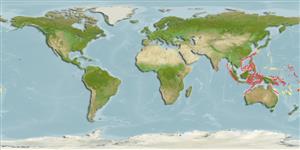Environment: milieu / climate zone / depth range / distribution range
Ökologie
seewasser bathydemersal; tiefenbereich 200 - 270 m (Ref. 9494). Deep-water
Western Central Pacific: Philippines, Indonesia and Australia.
Size / Gewicht / Alter
Maturity: Lm ? range ? - ? cm
Max length : 22.0 cm SL Männchen/unbestimmt; (Ref. 311)
Rückenflossenstacheln (insgesamt): 0; Rückenflossenweichstrahlen (insgesamt): 67-70; Afterflossenstacheln 0; Afterflossenweichstrahlen: 50 - 53. Color of preserved specimens tan to dark grey on the ocular side; tan or whitish on the blind side. Pectoral fin rays 11-13 on ocular side; 11-12 on blind side. Pelvic fin of ocular side with black spot and shorter than that on the blind side. Gill rakers elongate and pointed. 1st interhemal spine stout.
Inhabits mud and sand bottoms (Ref. 9774). Feeds on crustaceans and other benthic invertebrates (Ref. 9774).
Life cycle and mating behavior
Geschlechtsreife | Fortpflanzung | Ablaichen | Eier | Fecundity | Larven
Distinct pairing (Ref. 205).
Hensley, D.A. and K. Amaoka, 1989. A redescription of Pseudorhombus megalops, with comments on Cephalopsetta ventrocellata (Osteichthyes: Pleuronectiformes: Paralichthyidae). Proc. Biol. Soc. Wash. 102(3):577-585. (Ref. 2688)
IUCN Rote Liste Status (Ref. 130435)
Bedrohung für Menschen
Harmless
Nutzung durch Menschen
Mehr Information
ReferenzenAquakulturAquakultur ProfilZuchtlinienGenetikElectrophoresesVererbbarkeitKrankheitenVerarbeitungNutrientsMass conversion
Tools
Zusatzinformationen
Download XML
Internet Quellen
Estimates based on models
Preferred temperature (Ref.
123201): 11.7 - 20.8, mean 15 °C (based on 37 cells).
Phylogenetic diversity index (Ref.
82804): PD
50 = 0.5000 [Uniqueness, from 0.5 = low to 2.0 = high].
Bayesian length-weight: a=0.00741 (0.00343 - 0.01604), b=3.17 (3.00 - 3.34), in cm total length, based on LWR estimates for this Genus-body shape (Ref.
93245).
Trophic level (Ref.
69278): 3.5 ±0.44 se; based on food items.
Widerstandsfähigkeit (Ref.
120179): hoch, Verdopplung der Population dauert weniger als 15 Monate. (Preliminary K or Fecundity.).
Fishing Vulnerability (Ref.
59153): Low vulnerability (17 of 100).
